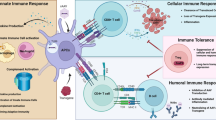Abstract
Siglecs, sialic acid-recognizing Ig-superfamily lectins, regulate various aspects of immune responses, and have also been shown to induce the endocytosis of binding materials such as anti-Siglec antibodies or sialic acid-harboring bacteria. In this study, we demonstrated that the expression of Siglec-9 enhanced the transfection efficiency of several cell lines such as macrophage RAW264 and non-hematopoietic 293FT cells. We applied this finding to the production of a lentiviral vector in which cells were transfected simultaneously with multiple vectors, and achieved a twice increase in viral production levels. Furthermore, 293FT cells expressing lectin-defective Siglec-9 produced three- to seven-fold higher titer of viral vector compared with parental 293FT cells. These results suggest that Siglec-9 enhanced lentiviral vector production in a lectin-independent manner.




Similar content being viewed by others
References
Ando M, Tu W, Nishijima K, Iijima S (2008) Siglec-9 enhances IL-10 production in macrophages via tyrosine-based motifs. Biochem Biophys Res Commun 369(3):878–883
Avril T, Freeman SD, Attrill H, Clarke RG, Crocker PR (2005) Siglec-5 (CD170) can mediate inhibitory signaling in the absence of immunoreceptor tyrosine-based inhibitory motif phosphorylation. J Biol Chem 280(20):19843–19851
Cheng PW (1996) Receptor ligand-facilitated gene transfer: enhancement of liposome-mediated gene transfer and expression by transferrin. Hum Gene Ther 7(3):275–282
Crocker PR, McMillan SJ, Richards HE (2012) CD33-related siglecs as potential modulators of inflammatory responses. Ann N Y Acad Sci 1253:102–111
Elfinger M, Maucksch C, Rudolph C (2007) Characterization of lactoferrin as a targeting ligand for nonviral gene delivery to airway epithelial cells. Biomaterials 28(23):3448–3455
Ikehara Y, Ikehara SK, Paulson JC (2004) Negative regulation of T cell receptor signaling by Siglec-7 (p70/AIRM) and Siglec-9. J Biol Chem 279:43117–43125
Jones C, Virji M, Crocker PR (2003) Recognition of sialylated meningococcal lipopolysaccharide by siglecs expressed on myeloid cells leads to enhanced bacterial uptake. Mol Microbiol 49:1213–1225
Kikuchi A, Sugaya S, Ueda H, Tanaka K, Aramaki Y, Hara T, Arima H, Tsuchiya S, Fuwa T (1996) Efficient gene transfer to EGF receptor overexpressing cancer cells by means of EGF-labeled cationic liposomes. Biochem Biophys Res Commun 227:666–671
Kodama D, Nishimiya D, Nishijima K, Okino Y, Inayoshi Y, Kojima Y, Ono K, Motono M, Miyake K, Kawabe Y, Kyogoku K, Yamashita T, Kamihira M, Iijima S (2012) Chicken oviduct-specific expression of transgene by a hybrid ovalbumin enhancer and the tet expression system. J Biosci Bioeng 113:146–153
Kovacs T, Karasz A, Szollosi J, Nagy P (2009) The density of GM1-enriched lipid rafts correlates inversely with the efficiency of transfection mediated by cationic liposomes. Cytometry A 75:650–657
Kunath K, Merdan T, Hegener O, Haberlein H, Kissel T (2003) Integrin targeting using RGD-PEI conjugates for in vitro gene transfer. J Gene Med 5:588–599
Lajaunias F, Dayer JM, Chizzolini C (2005) Constitutive repressor activity of CD33 on human monocytes requires sialic acid recognition and phosphoinositide 3-kinase-mediated intracellular signaling. Eur J Immunol 35:243–251
Motono M, Yamada Y, Hattori Y, Nakagawa R, Nishijima K, Iijima S (2010) Production of transgenic chickens from purified primordial germ cells infected with a lentiviral vector. J Biosci Bioeng 109:315–321
Nicoll G, Avril T, Lock K, Furukawa K, Bovin N, Crocker PR (2003) Ganglioside GD3 expression on target cells can modulate NK cell cytotoxicity via siglec-7-dependent and -independent mechanisms. Eur J Immunol 33:1642–1648
Orr SJ, Morgan NM, Elliott J, Burrows JF, Scott CJ, McVicar DW, Johnston JA (2007) CD33 responses are blocked by SOCS3 through accelerated proteasomal-mediated turnover. Blood 109:1061–1068
Paul SP, Taylor LS, Stansbury EK, McVicar DW (2000) Myeloid specific human CD33 is an inhibitory receptor with differential ITIM function in recruiting the phosphatases SHP-1 and SHP-2. Blood 96:483–490
Pilatte Y, Bignon J, Lambré CR (1993) Sialic acids as important molecules in the regulation of the immune system: pathophysiological implications of sialidases in immunity. Glycobiology 3:201–218
Rao GA, Tsai R, Roura D, Hughes JA (2008) Evaluation of the transfection property of a peptide ligand for the fibroblast growth factor receptor as part of PEGylated polyethylenimine polyplex. J Drug Target 16:79–89
Scott ES, Wiseman JW, Evans MJ, Colledge WH (2001) Enhanced gene delivery to human airway epithelial cells using an integrin-targeting lipoplex. J Gene Med 3:125–134
Tateno H, Li HY, Schur MJ, Bovin N, Crocker PR, Wakarchuk WW, Paulson JC (2007) Distinct endocytic mechanisms of CD22 (Siglec-2) and Siglec-F reflect roles in cell signaling and innate immunity. Mol Cell Biol 27:5699–5710
Ulyanova T, Blasioli J, Woodford-Thomas TA, Thomas ML (1999) The sialoadhesin CD33 is a myeloid-specific inhibitory receptor. Eur J Immunol 29:3440–3449
van der Velden VH, te Marvelde JG, Hoogeveen PG, Bernstein ID, Houtsmuller AB, Berger MS, van Dongen JJ (2001) Targeting of the CD33-calicheamicin immunoconjugate Mylotarg (CMA-676) in acute myeloid leukemia: in vivo and in vitro saturation and internalization by leukemic and normal myeloid cells. Blood 97:3197–3204
Varki A, Angata T (2006) Siglecs—the major subfamily of I-type lectins. Glycobiology 16:1R–27R
Ventura A, Meissner A, Dillon CP, McManus M, Sharp PA, Van Parijs L, Jaenisch R, Jacks T (2004) Cre-lox-regulated conditional RNA interference from transgenes. Proc Natl Acad Sci USA 101(28):10380–10385
von Gunten S, Yousefi S, Seitz M, Jakob SM, Schaffner T, Seger R, Takala J, Villiger PM, Simon HU (2005) Siglec-9 transduces apoptotic and nonapoptotic death signals into neutrophils depending on the proinflammatory cytokine environment. Blood 106(4):1423–1431
Walter RB, Raden BW, Zeng R, Hausermann P, Bernstein ID, Cooper JA (2008) ITIM-dependent endocytosis of CD33-related Siglecs: role of intracellular domain, tyrosine phosphorylation, and the tyrosine phosphatases, Shp1 and Shp2. J Leukoc Biol 83(1):200–211
Zhang M, Angata T, Cho JY, Miller M, Broide DH, Varki A (2007) Defining the in vivo function of Siglec-F, a CD33-related Siglec expressed on mouse eosinophils. Blood 109(10):4280–4287
Acknowledgments
This work was partly supported by the Takeda Foundation, Mishima Foundation, and Terumo Foundation.
Author information
Authors and Affiliations
Corresponding author
Rights and permissions
About this article
Cite this article
Shoji, T., Higuchi, H., Zaitsu, Y. et al. Enhanced lentiviral vector production in 293FT cells expressing Siglec-9. Cytotechnology 67, 593–600 (2015). https://doi.org/10.1007/s10616-013-9679-7
Received:
Accepted:
Published:
Issue Date:
DOI: https://doi.org/10.1007/s10616-013-9679-7




